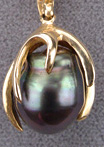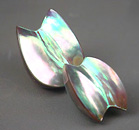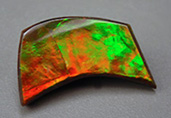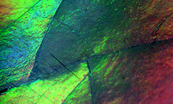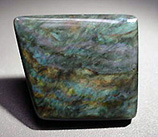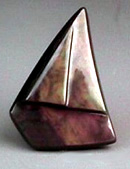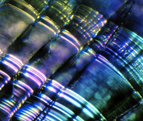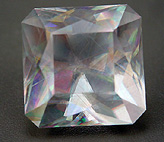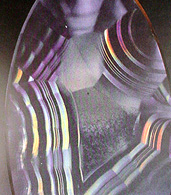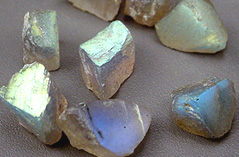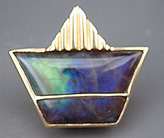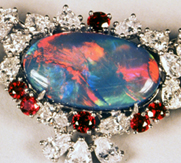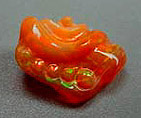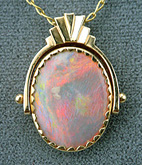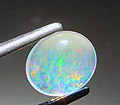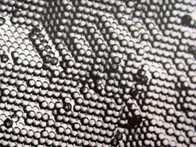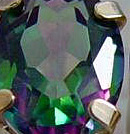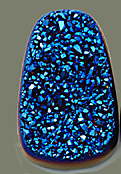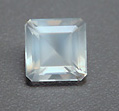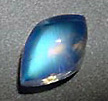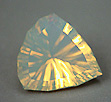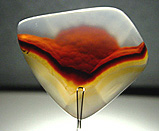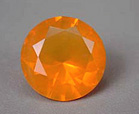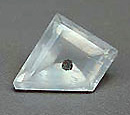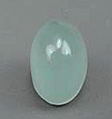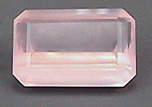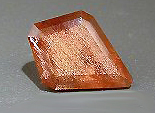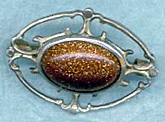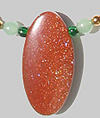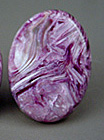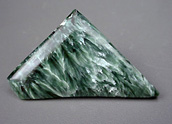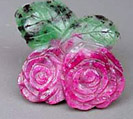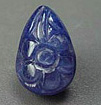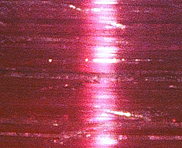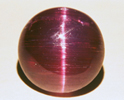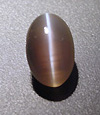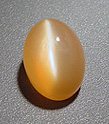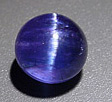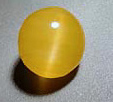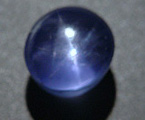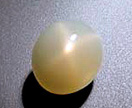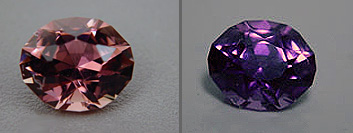
| OPTICAL PHENOMENA IN GEMS Optical phenomena encompass the light-dependent properties of a gem, which are not due to its basic chemical and crystalline structure, but rather, due to the interaction of light with certain inclusions or structural features within the gem.
Major Optical Phenomena in Gemstones :
Iridescence
:
When combined with interference, where the slightly out of phase color waves bouncing off different layers overlap as they reflect, a loss of some colors and a reinforcement of others can take place giving rise to dramatic color blocks, which may shift with viewing angle.
Iridescence is the most widespread of the optical phenomena, we see its effects in: the "orient" of pearls, the displays of fire agate, "rainbow calcite", certain obsidians, and iris agate. It also creates the rainbow display of fractures, the beautiful colors of Labradorite, and, probably most well known, the "color play" of precious opal.
Pearls :
Baroque freshwater Cultured Pearl
Cultured Tahitian Black Pearl
Abalone Shell Doublets
Fire Agate :
Fire Agate Cabochon in a pendant
A close up view of some Fire Agate colors Ammolite
:
The thickness of the preserved layers controls the colors that will be seen. Thicker layers produce red or orange colors, and thinner ones, the blues and violets. Due to the fragility of the thinnest layers, specimens with blue or violet color are especially rare and costly.
Specimen with rare blue and violet colors
One with the more commonly seen red
10x view of green, blue and red iridescence on an ammolite
Phenomenal Obsidian :
Rainbow Obsidian Cab
Rainbow Obsidian cut as a "cat's eye"
Velvet Obsidian Fractures/Cleavages
:
Conchoidal fracture in Aquamarine There are other cases, where rather than revealing a defect, the presence of microscopic fractures or cleavages is responsible for the beauty of a particular gem. Two examples which are admired by collectors are known as "rainbow calcite" and "iris quartz".
Iris Quartz Iridescence
due to internal micro-cleavages
Labradorescence
:
The finest pieces have strong displays which skilled cutters take care to orient to best advantage for the face-up view. The lovely cabochon pair and brooch below show how bright and attractive the display can be, but if they were turned to a different angle, that beauty would temporarily be lost, only to return again as the pieces were moved in another direction.
Labradorite Feldspar Rough
Labradorite Cabochons
Labradorite Brooch Play
of color :
Black Opal
Precious Mexican Opal
White precious Opal pendant
Matrix Opal
Contra Luz Opal (a rare type with a different display of colors in reflected versus transmitted light) Play of color is seen as shifting patches of spectral colors on the gem's surface and/or in its the interior. This phenomenon is caused by the unique ultrastructure of the opal. The graphic below represents an interior view of opal at 25,000X via the electron microscope. Opal is made of spheres of cristobalite silica, SiO2(a polymorph of quartz). These are arrayed in closely stacked layers and have air, or more rarely, liquid, in between them. (To picture something similar on a larger scale, think of a crate of oranges with the fruit neatly arrayed into rows.) The openings act as diffraction gratings which split the light into colors, and the layered structure creates interference. As the light is reflected from the various layers the, now slightly out of sync waves overlap, decreasing or removing certain spectral colors, and reinforcing others. Thus, we get a shifting group of colors which flicker on and off, and move as we twist and turn the gem altering the light path and viewing angle. Which colors are seen is a function of the size and regularity of the spheres (with smaller spheres more blue is seen, with larger ones more red) and of our angle of view.
25,000x magnification of the structure of Opal In common opal, the openings between the spheres are so large that light doesn't have to bend when traveling through them, so that no diffraction takes place. Rather, the scattering and bouncing of light off the inner particles creates a sort of hazy effect commonly known as "opalescence". (Actually, opalescence is an example of another phenomenon called adularescence, see below.)
Yellow common Opal showing typical Opalescent Haze Man-made
Iridescence :
Mystic TopazTM
Titanium Drusy Adularescence
:
Moonstone :
Adularescence in moonstone : white, blue and rainbow moonstones Adularescence
in other species :
Girasol Opal and Agate This general scattering of light, often is not distinctive, but rather shows up as subtle haziness, as in the case of the opalescence of common opal. Frequently we see the term "milky" used to describe individual specimens of a usually non-hazy species which show this type of adularescence. An exception is rose quartz which is virtually always hazy, so it doesn't need a special adjective, like milky, to distinguish it.
Opalescent Haze in common Opal
Milky Quartz with Pyrite inclusion
Milky Aqua
Rose Quartz Aventurescence
:
The name is derived from the Italian word for "chance" or accident, and has no "d" in it! Quite frequently, even among those who should know better (like shopping channel hosts), the word is mispronouced as "adventurine". The most commonly encountered species showing this effect are certain feldspars and one variety of quartz.
Aventurine Quartz (mica platelets) "Goldstone", a man-made aventurescent glass with copper particles deliberate
ly added to it, has been an inexpensive and popular gem imitation since Victorian times, and remains commonly in use today.
Goldstone Glass in a Victorian brooch, Circa 1880
Goldstone Glass in a contemporary pendant Chatoyancy
:
Simple
chatoyance :
Less familiar to many, but greatly admired for their displays of chatoyance are the purple Charoites and the silvery grey serefinites.
Corundum often contains rutile needles but frequently they are not abundant or organized enough to produce a star gem, and instead show up as a general silky glow, as seen in the ruby and sapphire carvings below.
Tiger's Eye
Charoite
Serefinite
Ruby in Zoisite
Sapphire
The cat'seye effect :
The pictures below show a close up of the parallel growth tubes in a rubellite tourmaline and the effect seen in that gem when it is viewed with proper lighting.
Parallel growth tubes in a Rubellite
Gem displaying its Cat's Eye Cat's Eye gems have been popular throughout history, especially in the Orient. Cat's Eye Chrysoberyl is the most valued of all, and it has traditionally been given the honor of simply being called "Cat's Eye", whereas all other types, technically require a species modifier like: Cat's Eye Tourmaline, Cat's Eye Moonstone, etc.
Plain Cat's Eye (chrysoberyl)
Cat's Eye Moonstone Fine quality Cat's Eye gems show some translucency, have a strong, well centered and straight eye and "do tricks". By that I mean :
1. With the light overhead, we see a strong eye
2. By moving the light source to one side and lighting the gem laterally, we get the "milk and honey" effect, (one side light, one side dark)
3. By using two lights and moving them from the center to the side, the eye will split into two bands each of which follows one of the light sources (opening and closing).
These effects are shown in the pictures of the Cat's Eye (chrysoberyl) gem below : Cat's Eye tricks
Single eye
Milk and honey effect
The beginning of the opening and closing effect as the single eye is splitting into two The most commonly encountered cat'seyes are tourmalines, moonstones, chrysoberyl and quartz. Below is a selection of some gems that are extremely rare in cat's eye form :
Cat's Eye Tanzanite
Zircon
Precious Topaz Asterism
:
Depending on the nature of the inclusions and the crystal system of the host, a four or six rayed star will generally be displayed. By far, the most common star stone species is corundum, with quartz a distant second. Stars are relatively rare in other species.
Ruby
Sapphire
White Sapphire
Rose Quartz (6 rayed)
Moonstone (4 rayed) Color
change :
The completeness of the change is usually designated by percentage, for example, we might say that a particular stone shows a 70% color change. Although natural stones rarely show a complete color change, synthetic and simulant color change stones have been made which create the effect very strongly.
In addition to Alexandrite chrysoberyl, other species which are occasionally found in color change forms are: sapphire, spinel, garnet, tourmaline and diaspore. Alexandrite
Incandescent (blue-violet)
Day light (teal) Color change tourmaline
Incandescent (mauve pink) and Day light (purple) Man-made color change glass
"Tourmalike rough : Incandescent (slightly orangey pink), daylight (slightly brownish green) |

